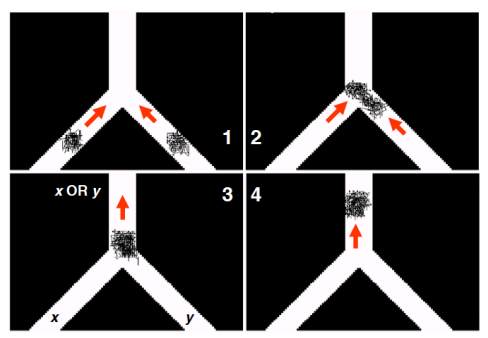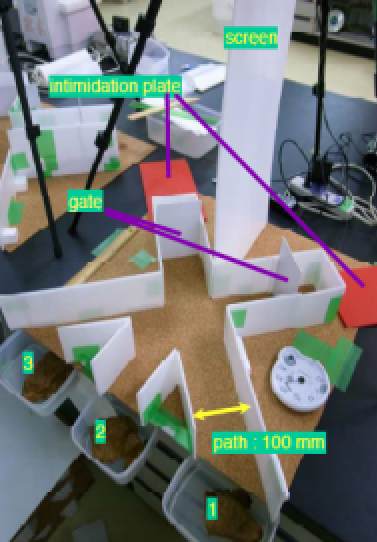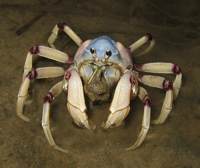| A Crab-Based Computer |
| Written by Lucy Black | |||
| Sunday, 15 April 2012 | |||
|
You can build a computer out of all sorts of things - mechanical components, vacuum tubes, transistors, fluids and ... crabs. Researchers have discovered that soldier crabs have behaviors suitable for implementing simple logic and hence - with enough crabs - you can achieve a complete computer.
Given that computation is possible with a range of simple mechanisms, it should come as no surprise that you can use the flocking behaviour of crabs for the job; but somehow it does. The Soldier crab Mictyris guinotae has a swarming behavior that is just right for simple logic gates. When two crab swarms collide they fuse to make a single swarm - and this is enough to build an OR gate:
The OR gate is easy but we need a little more for universal computation. How about an AND gate? This isn't quite as easy, but if you add the observation that a fused swarm continues to move in the average direction of the two original balls, you can start to see possibilities. The solution is a little more complicated than the OR, in that we also have outputs for NOT x AND y and x AND NOT y, but concentrate on what happens if you put two swarms in at x and y at the same time. They simply exit at the x AND y output because that is their average direction:
To convince yourself that this really is an AND gate, consider what happens for a crab swarm at x alone - the swarm carries on in the same direction and exits at x AND NOT y. It does work because you only get an output at the AND exit when there is a crab swarm at x and one at y. This is all you need to create a NOT gate and hence you now have OR, AND and NOT and an entire crab- based computer. The researchers not only simulated the whole idea, they actually implemented some gates using live crabs and discovered that they were fairly reliable. You can see an AND gate implemented in acrylic and, of course, crab:
The researchers, Yukio-Pegio Gunji, Yuta Nishiyama and Andrew Adamatzky, working at Kobe University, Waseda University and the Unconventional Computing Centre in Bristol, are to be congratulated for proving that more or less anything can be turned into a computer. The paper also reports that: ...after all experiments the crabs were released to their natural habitats. Furthermore, on visual inspection, no crabs appeared to have been injured or adversely a effected by the experiments.
Credit LiquidGhoul
We await the first crab-based full adder with anticipation. More InformationRobust Soldier Crab Ball Gate Related ArticlesSlime mould simulates Canadian transport system To be informed about new articles on I Programmer, sign up for our weekly newsletter, subscribe to the RSS feed and follow us on Twitter, Facebook or Linkedin.
Comments
or email your comment to: comments@i-programmer.info |
|||
| Last Updated ( Wednesday, 17 July 2019 ) |





